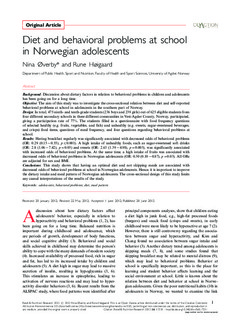| dc.contributor.author | Øverby, Nina Cecilie | |
| dc.contributor.author | Høigaard, Rune | |
| dc.date.accessioned | 2012-07-25T13:21:27Z | |
| dc.date.available | 2012-07-25T13:21:27Z | |
| dc.date.issued | 2012 | |
| dc.identifier.citation | Øverby, N., & Høigaard, R. (2012). Diet and behavioral problems at school in Norwegian adolescents. Food & Nutrition Research, 56: 17231. | no_NO |
| dc.identifier.issn | 1654-661X | |
| dc.identifier.uri | http://hdl.handle.net/11250/139017 | |
| dc.description.abstract | Background: Discussion about dietary factors in relation to behavioral problems in children and adolescents has been going on for a long time.
Objective: The aim of this study was to investigate the cross-sectional relation between diet and self-reported behavioral problems at school in adolescents in the southern part of Norway. Design: In total, 475 ninth- and tenth-grade students (236 boys and 239 girls) out of 625 eligible students from four different secondary schools in three different communities in Vest-Agder County, Norway, participated, giving a participation rate of 77%. The students filled in a questionnaire with food frequency questions of selected healthy (e.g. fruits, vegetables, and fish) and unhealthy (e.g. sweets, sugar-sweetened beverages, and crisps) food items, questions of meal frequency, and four questions regarding behavioral problems at school.
Results: Having breakfast regularly was significantly associated with decreased odds of behavioral problems (OR: 0.29 (0.15-0.55), p ≤0.001). A high intake of unhealthy foods, such as sugar-sweetened soft drinks (OR: 2.8 (1.06-7.42), p=0.03) and sweets (OR: 2.63 (1.39-4.98), p=0.003), was significantly associated with increased odds of behavioral problems. At the same time, a high intake of fruits was associated with decreased odds of behavioral problems in Norwegian adolescents (OR: 0.30 (0.10-0.87), p=0.03). All ORs are adjusted for sex and BMI.
Conclusions: This study shows that having an optimal diet and not skipping meals are associated with decreased odds of behavioral problems at school in Norwegian adolescents. Hence, it is important to improve the dietary intake and meal pattern of Norwegian adolescents. The cross-sectional design of this study limits any causal interpretations of the results of the study. | no_NO |
| dc.language.iso | eng | no_NO |
| dc.publisher | Swedish Nutrition Foundation | no_NO |
| dc.rights | Navngivelse-Ikkekommersiell 4.0 Internasjonal | |
| dc.rights.uri | http://creativecommons.org/licenses/by-nc/4.0/deed.no | |
| dc.title | Diet and behavioral problems at school in Norwegian adolescents | no_NO |
| dc.type | Journal article | no_NO |
| dc.type | Peer reviewed | no_NO |
| dc.rights.holder | © 2012 The Author(s) | |
| dc.subject.nsi | VDP::Medical disciplines: 700::Health sciences: 800::Nutrition: 811 | no_NO |
| dc.source.pagenumber | 1-6 | no_NO |
| dc.source.volume | 56 | no_NO |
| dc.source.journal | Food & Nutrition Research | no_NO |
| dc.identifier.doi | https://doi.org/10.3402/fnr.v56i0.17231 | |
| dc.source.articlenumber | 17231 | |

